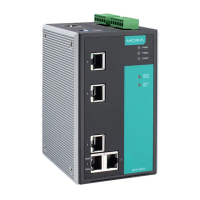Multicast transmission makes more sense and is more efficient than unicast transmission for some applications.
For example, multicasts are often used for video-conferencing, since high volumes of traffic must be sent to
several end-stations at the same time, but where broadcasting the traffic to all end-stations would cause a
substantial reduction in network performance. Furthermore, several industrial automation protocols, such as
Allen-Bradley, EtherNet/IP, Siemens Profibus, and Foundation Fieldbus HSE (High Speed Ethernet), use
multicast. These industrial Ethernet protocols use publisher/subscriber communications models by
multicasting packets that could flood a network with heavy traffic. IGMP Snooping is used to prune multicast
traffic so that it travels only to those end destinations that require the traffic, reducing the amount of traffic on
the Ethernet LAN.
Multicast Filtering
Multicast filtering ensures that only end-stations that have joined certain groups receive multicast traffic. With
multicast filtering, network devices only forward multicast traffic to the ports that are connected to registered
end-stations. The following two figures illustrate how a network behaves without multicast filtering, and with
multicast filtering.
Network without multicast filtering
Multicast Filtering and Moxa’s Industrial Rackmount Switches
The Moxa switch has three ways to achieve multicast filtering: IGMP (Internet Group Management Protocol)
Snooping, GMRP (GARP Multicast Registration Protocol), and adding a static multicast MAC manually to filter
multicast traffic automatically.

